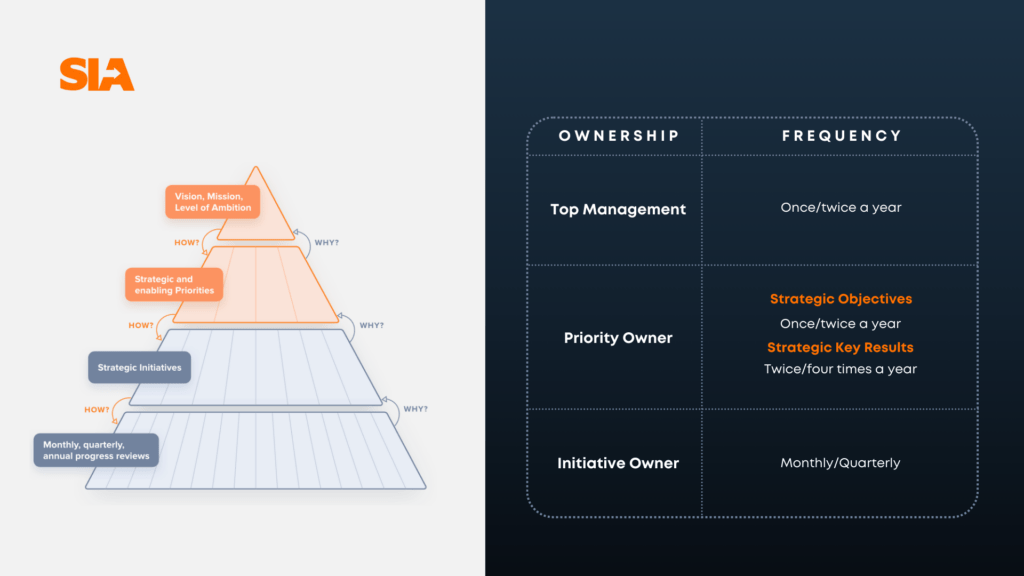
While “strategic planning” is a commonly used construct, it is crucial to understand that strategy and planning are distinct concepts. To ensure the long-term success of their business, a company’s leadership team must clearly grasp and effectively utilise both.
What is Strategy?
Strategy involves making choices—fundamental decisions on the direction and scope of an organisation. These choices are based on assumptions, or a theory, about how to win and are meant to ensure that the company achieves long-term success. For example, in which market spaces should the company compete, and how?
Strategy, therefore, deals with uncertainty. The leadership team may, for example, develop a theory that entering a specific market space will strengthen the company’s competitive advantage. However, they can only validate this theory after entering that market space and observing the actual performance.
Although the leadership team may anticipate a positive reception of the company’s products, they do not control consumer buying behaviour. As Professor Roger Martin put it, “True strategy is about placing bets and making hard choices. The objective is not to eliminate risk but to increase the odds of success.”[i]
What is Planning?
Planning, on the other hand, involves systematically organising activities and schedules and allocating resources to ensure that the objectives of the organisation are met efficiently and effectively. The purpose of planning is to create a roadmap that guides day-to-day operations.
Hence, planning deals with certainty. The company has full control over how resources will be allocated among departments and projects, can choose which initiatives to pursue, and can establish clear timelines for their execution.
How Do Strategy and Planning Come Together?
From the certainty/uncertainty perspective, managers may feel more comfortable dealing with planning rather than strategy. However, for an organisation to succeed, its management must both formulate a strategy—defining a vision and strategic objectives—and plan the necessary steps to achieve these goals.
A plan without a strategy is merely an exercise in execution, which is not sustainable in the long term. Conversely, a strategy without a plan is merely a beautiful exercise in abstraction.
To ensure that strategy and planning work together in a complementary manner, a company’s leadership team needs to establish a well-thought-out Progress Review process.
The Progress Review: Rationale
The Progress Review is a structured process that serves two main functions. First, it enables the company to verify that the projects and initiatives outlined in the plan are being executed as intended. Second, it serves to validate the hypotheses underlying the strategy.
As mentioned, strategy cannot be proven in advance. By tracking and reviewing actual performance, the leadership team can assess whether the assumptions upon which the strategy is based have stood the test of the market. In this way, when some of these hypotheses inevitably prove incorrect, instead of blindly following the plan, the leadership team can adapt and modify it accordingly.
How can both functions be achieved? Through the implementation of OKRs. (See OKRs: Easy to Understand, Difficult to Master for details on this goal-setting framework.)
The Progress Review: Levels
The basis for a sound Progress Review process is having a meaningful OKR framework in place that connects the strategy with its implementation efforts. In other words, the company must have cascaded its high-level long-term objectives and key results—namely, the Vision, Mission, and Level of Ambition—down to Strategic Key Results, and then further down to the objectives and key results at the initiative level.

The Progress Review must be conducted at all three levels, although with varying frequency, starting from the bottom of the pyramid.
First, OKRs at the initiative level need to be tracked and reviewed frequently to monitor the actual unfolding of the projects that have been approved. For instance, is the product simplification the company decided to implement to enter a particular market space actually completed? If not, it cannot be expected that the higher-level objective that this initiative was meant to address has progressed. Therefore, the initiative owner must verify that the initiative has been completed within the planned timeline and specifications.
Second, after a few months of Progress Reviews on initiatives, it’s beneficial to examine whether the key results of the priorities, namely the Strategic Key Results, are actually being met. For example, if the product has been simplified and a daily sales target of X was set from the time the simplified product was launched, but sales are not moving, that is an early signal that although the activities are being carried out, the choices might have been wrong.
Priorities are reviewed with a slightly lower frequency since they are aggregates of initiatives and projects. As a result, to see movement in these indicators and to obtain a concrete validation of the underlying hypothesis, more time is needed. There needs to be sufficient progress in these initiatives and projects to reasonably expect to see relevant signals.
Third, once or twice a year, it is important to conduct a Progress Review at the Level of Ambition. Due to its highly aggregated nature, more frequent reviews would not provide clear signals regarding the validity of hypotheses and may actually provide a distorted signal, since short-term fluctuations may not be indicative of the hypotheses’ validity.
The Progress Review: Process
At each level, the Progress Review needs to tackle the same four questions:
For instance: Which initiatives do we keep because they’re proving effective? What initiatives do we kill because they’re not effective and are consuming resources without producing the intended outcomes? Are there any initiatives we need to add? Are there any changes needed, such as redefining certain projects or initiatives, or allocating additional resources?
The answers to these questions will have an impact on both the strategy and the planning. In other words, they will indicate whether the strategic choices need to be changed due to the validity or invalidity of the hypotheses, and also whether the implementation actions will need to be adjusted to meet the strategic goals.
This strategic review process offers both stability in terms of the overall direction of the company and flexibility to respond to feedback coming from the market. In this way, strategy works hand in hand with planning to enable true Strategy in Action.
References
Harvard Business Review, “Roger L. Martin | A Plan Is Not a Strategy,” YouTube video, June 29, 2022, https://www.youtube.com/watch?v=iuYlGRnC7J8, accessed July 2024.
John Doerr, Measure What Matters: How Google, Bono, and the Gates Foundation Rock the World with OKRs (New York: Portfolio/Penguin, 2018).
[i] Roger L. Martin, “The Big Lie of Strategic Planning,” Harvard Business Review, January–February 2014, https://hbr.org/2014/01/the-big-lie-of-strategic-planning, accessed July 2024.